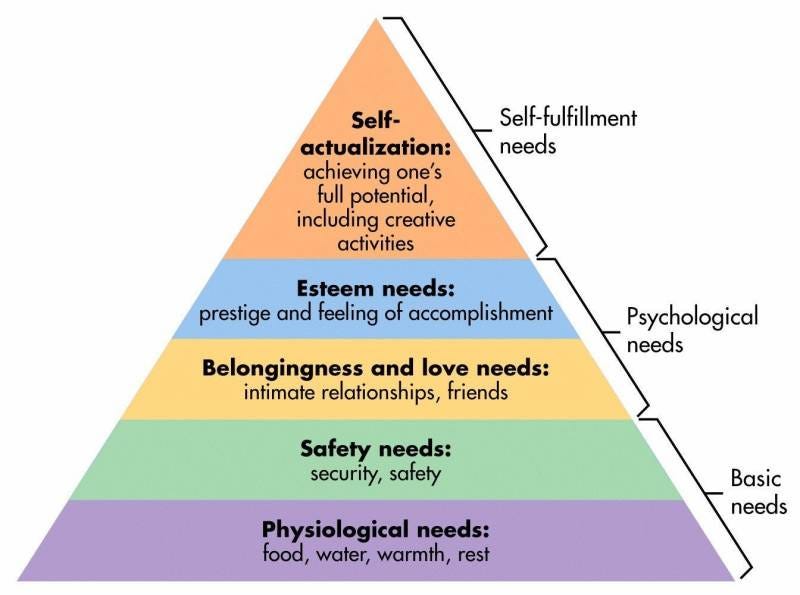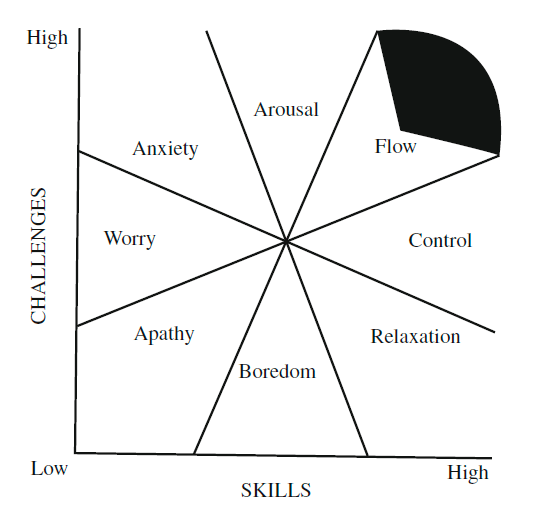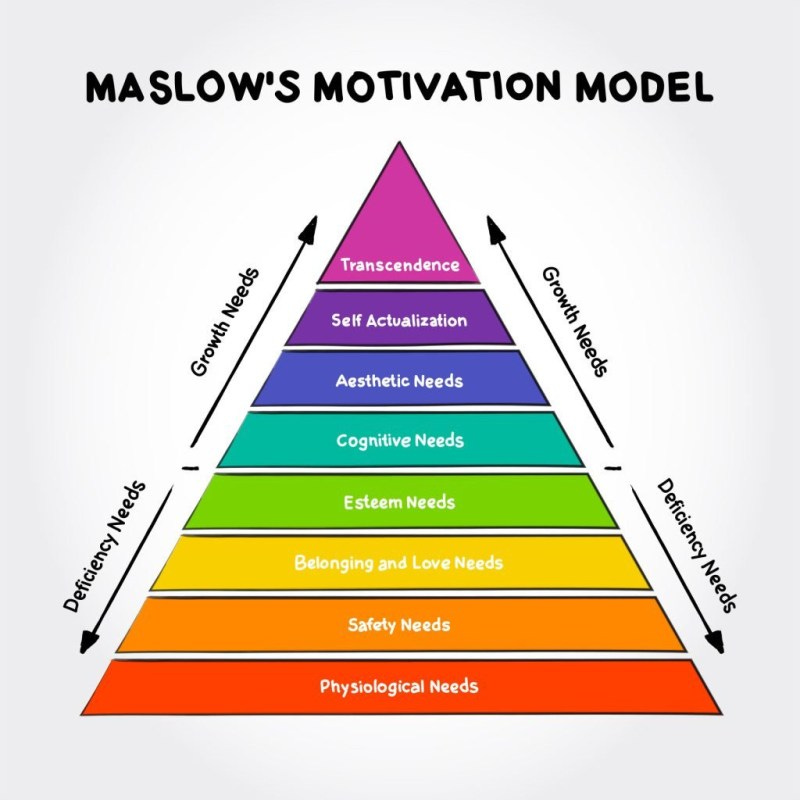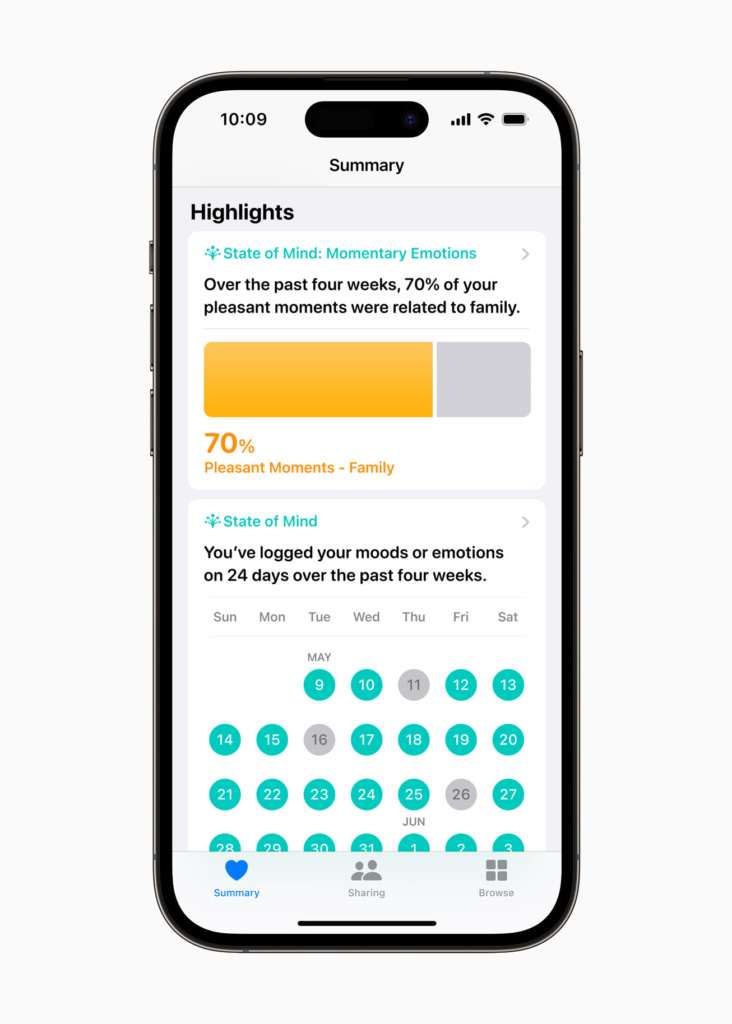Welcome to Recalibrating! My name is Callum (@_wanderloots)
Join me each week as I learn to better life in every way possible, reflecting and recalibrating along the way to keep from getting too lost.
Thanks for sharing the journey with me ✨
This week we are going to talk about the final deficiency need of Maslow's Hierarchy: Esteem.
Recap from Last Week
Last week, we finished Level 3 of Maslow's Hierarchy: Belonging and Love Needs. Over the course of Entries 12-16, I explored this level with an analysis of what it means to build True Community through Story. I also elaborated on the three pillars of story: Character, Plot, and Setting, describing how these pillars weave together to form the self.
This week, we are going to continue with the next level of Maslow's Hierarchy: Esteem Needs. I have been looking forward to writing about this topic since I began my Recalibrating journey 16 weeks ago.
In this Entry, I provide an overview of esteem, common issues that prevent people from levelling up their confidence, and some suggestions on how to boost your esteem over time.
Let's dive in ✨
Overview of Self-Actualization
Esteem is the final deficiency need in Maslow's Hierarchy, a need which, if not met, prevents an individual from self-actualizing.
We have touched on self-actualization many times over the last 16 weeks, but I think it is time to elaborate on what that means now that we have reached the esteem level.
Self-actualization, put simply, is becoming who you were meant to be. To reach your full potential.
A quote from Maslow about self-actualization:
It may be loosely described as the full use and exploitation of talents, capabilities, potentialities, etc. Such people seem to be fulfilling themselves and to be doing the best that they are capable of doing. They are people who have developed or are developing to the full stature of which they capable."
Self-actualization is unique to each individual, but there are many common prerequisites. These commonalities form the structure of Maslow's Hierarchy, the path of potential.
While the "hierarchy" of Maslow's Hierarchy faces criticism for being too rigid (the levels do not need to be satisfied in order), the elements of the pyramid do make sense as building blocks of self-actualization.

All four foundational levels are referred to as deficiency needs. If these needs are not met, self-actualization becomes difficult, if not impossible. Deficient.
Basic Needs:
Level 1: Physiological Needs
Level 2: Safety Needs
If we are constantly worried about food, water, shelter, safety, finances, it can be difficult to reach the best version of ourselves. Our time and attention are focused primarily on survival rather than growth.
Psychological needs:
Level 3: Belonging and Love Needs
Level 4: Esteem Needs
Humans are community-based creatures. We have survived over the millennia by forming groups and working together to make survival easier. If we do not have community or believe that we are adequately contributing to our community, it can be difficult to become the best version of ourselves. Our time and attention are focused primarily on what others think of us rather than growth.
I wanted to provide a recap of the various levels of self-actualization before getting into esteem because esteem is, in my opinion, the biggest block towards self-actualization for most people.
It's hard to grow if you don't believe you can.
Esteem and Growth
We are not born with esteem, we grow it.
Esteem is somewhat paradoxical in nature. We need esteem to grow, but to build esteem, we need to grow. Confused? That's okay, paradoxes are not meant to be understood, they are meant to be experienced.
We need to believe we can grow in order to satisfy our esteem needs, which in turn enables us to reach the growth phase of Maslow's Hierarchy (self-actualization).
As an aside, I am currently reading Both/And Thinking: Embracing Creative Tensions to Solve Your Greatest Problems. Rather than viewing the world as either this or that, we can consider both this and that. Paradoxes underly every aspect of our lives. Self and other, tradition and innovation, stability and change. By trying to put our problems into discrete boxes, we lose the nuances of life.
Esteem is a paradoxical balance between self and other. This book has helped me to understand the tensions that underlie my reality as I learn to grow and change ✨
But what is esteem? It's a word that is thrown around a lot, but usually in a superficial manner. What does it actually mean to develop esteem?
Esteem has two major components: external esteem and internal esteem.
Internal and External Esteem
External esteem can be thought of as respect, status, recognition, prestige. As humans, we desire respect and recognition. We want to be both accepted and valued by others. Acceptance by others falls more under Level 3 of the hierarchy, whereas the value appreciation by others falls within the esteem level.
Internal esteem (self-esteem) can be thought of as self-belief, freedom, mastery, dignity.
I view many of these characteristics (if not all) as a subset of confidence. Confidence is "a feeling of self-assurance arising from one's appreciation of one's own abilities or qualities". We can be confident in ourselves (internal) and others can have confidence in us (external).
People have wondered for years how I can be so confident. "How can you do that?" "How do you speak in front of all of those people?" "How do you know this to be true?" "How are you not afraid to share your creativity online"?
What they don't realize (even when I try to tell them) is that confidence is not something we are born with. I worked very hard for many years to develop skills in areas I am passionate in. Confidence does not appear over night. It builds over time. If you want to learn more, Atomic Habits does an excellent job explaining the connection between identity and iterative gains.
People prefer to hear that their deficiencies are outside of their control because that means they do not have the power to change their situation, so they do not even need to try. This is false.
Also, there is a difference between being afraid, and letting fear control your actions. Fear is natural, arising from our exploration of the unknown. Confidence comes from the internal anchors we have laid, preventing the turbulence of fear from sweeping us away.
Confidence is not innate. Confidence is something we grow.
By valuing our own abilities or qualities (self-esteem) we are able to project confidence that, in turn, builds external esteem. Confidence helps us project our value externally where it can be seen and appreciated by others.
It's a paradox. We develop self-confidence in our own abilities and project that confidence to be valued by others, which in turn boosts our self-confidence. Cyclic Confidence.
Problems of Esteem
The path of developing external esteem is rife with danger to our self-esteem. Seeking validation from others can lead to problems that can blow-up our self-esteem if we are not ready to face them.
Here are a few common issues that arise from too much focus on external esteem:
Over-reliance on external validation for self-worth.
Fear of judgment and criticism from others.
Vulnerable to change in reputation and societal status.
Imposter syndrome from over-reliance of external indicators.
Lack of fulfillment and authenticity.
This damage to our self-esteem caused by external sources can create or deepen issues we already face with our self-confidence, making it even more difficult to stabilize our sense of self.
Regardless of external validation issues, our self-esteem also may not have developed sufficiently over the course of our lives, leaving us with low confidence.
Here are some common issues with internal esteem (self-esteem):
Negative self-talk and a critical self-image.
Lack of self-compassion.
Failure to self-actualize due to lack of self-confidence.
Comparison to others, leading to a sense of inadequacy (comparision is the thief of joy).
Again, we are left with a paradox: furthering our external esteem can lead to over-reliance on others, leading to issues with our self-esteem. Deficient self-esteem can prevent us from taking actions to develop our external esteem. We require both self-esteem and external esteem, but they are pulled across the tension of self and other. We cannot develop one or the other, we have to develop both while balancing each.
Why is developing esteem, internal or external, so difficult for us?
Difficulties With Growing Esteem
Typically, we seek to develop esteem through our hobbies (self) and profession (others). These are areas that we can grow confident in our own abilities and gain recognition for our contribution to society.
As children and teenagers, we often have a wide range of hobbies that we participate in on a regular basis. Sports, art, movies, music, reading, games, etc.
However, as we grow up and become employed adults, our focus shifts away from prioritizing actions that bring us pleasure for its own sake to actions that bring us income.
Part of this shift occurs due to the need to make money (Level 2 of the Hierarchy) and part of this shift occurs from trying to achieve accomplishments that will increase how our peers and bosses view our value to the company (external esteem). In both cases, we often shift away from the self (hobbies) towards the other (career accomplishment = external validation).
We begin to value the external more than the internal. Our self-esteem becomes externally anchored rather than internally anchored. Our self shrinks from the lack of self-attention and self-awareness.
As we grow and change, so does what matters to us. We let go of the hobbies we used to love and we fill the void with actions that may bring us external validation. We begin to care more about what we should do (what matters to others), not what actually matters to us.
When we receive external validation for our actions, we double down on those actions to increase our accomplishments and perceived value. We stop trying new things, favouring what works now based on what has worked for the company in the past. We stop revisiting the old things, what we used to love growing up.
We stop exploring. We stop playing.
Why?
Well, the reason will vary for each person. Some people experience social anxiety at the thought of not fitting in. Others develop inferiority complexes seeing others in their profession achieve greater accomplishments. Some have a fear of criticism engrained in them from childhood.
I talk about this subject more with Giulia Gartner in The Bigger Picture: Social Networking and Anxiety.
Of course, this imbalance between self and other does not occur for everyone, in every situation. The whole point of this self-actualization reflection is to identify the parts that resonate with you on your own path.
When was the last time you did something 100% for yourself?
When was the last time you tried something new?
Growth and Change
The above discussion centres around what makes esteem a deficiency need; the reasons why we struggle to move from this level of the hierarchy towards self-actualization.
To help us satisfy these esteem deficiencies, let's look ahead to the next tier of the hierarchy: growth needs.
When esteem is satisfied, a stable foundation of the four deficiency needs is laid, enabling us to explore the growth needs. More on growth needs of the expanded hierarchy (cognitive and aesthetic) later.
Self-actualization arises from a change of the self to reach your full potential. Growth.
However, self-actualization is not an end goal. It is not a finish line to be crossed.
Instead, it is a continual state of becoming who you are meant to be. A personalized philosophy that provides your path to walk. A practice of growth and discovery. An opportunity to begin again.
Growth necessitates change, yet fear fixes us in place, preventing change.
How can we change?
Hint: it involves trying new things.
Self-Awareness
You may be tired of hearing it from me at this point, but the best place to begin developing your esteem is through self-awareness. Where is your esteem lacking? Where is it excelling? Are you struggling with self-esteem or external esteem? There is no one way or right answer, there is only multi-dimensional living.
Self-awareness, reflection, journalling, metacognition, controlling your attention. Tools of change.
There is a reason I continuously emphasize these skills. Controlling the desired change in your own life becomes infinitely easier if you are aware of what you actually want to change in the first place.
Identify areas where you feel unfulfilled or drained
Identify areas where you feel sad or depressed
Identify areas where you feel happy or excited
If you have an Apple iPhone, iPad, or watch, the latest update to the health app enables the logging of "state of mind". This feature is an excellent way to instantaneously track how you are feeling in a given moment, which can later be linked to the activity you were partaking in at the time.
Track these areas over days, weeks, months, and years. The more you become aware of your own behaviour and how your experiences impact your happiness, the more your pattern will reveal itself to you. Increase the positives and decrease the negatives. Repeat.
For more information, feel free to revisit any of the below entries for more information on developing self-awareness.
If you would like to learn more about the tools and workflows I use for identifying my own patterns, please consider upgrading your subscription to paid. As I build my second brain and research AI integration, I have completely changed how I operate on a day-to-day based on the patterns I have identified in my thinking and behaviour.
Autotelic Exploration
To overcome the fear of change, we need to practice living in the unknown. We need to explore experiences that we are not familiar with or have forgotten how to experience.
However, just because these experiences are new (or relatively new) does not mean that they need to be unnatural.
Building esteem can often feel unnatural. I believe this unnatural feeling arises when we try to do things that we feel we should do, rather than what we actually want to do. If our actions do not align with our values, we experience burnout. We are drained of our energy.
Instead of thinking of accomplishments based on the expectations of others, focus on the self first. Once the self is stabilized with internal anchors (self-esteem), we can move on to external esteem.
But how can we develop these internal anchors?
The best way to recalibrate the self, in my opinion, is to pursue autotelic experiences.
Autotelic comes from the words "autos" meaning self and "telos" meaning final result, or purpose. Self-purpose. Intrinsic motivation.
In other words, autotelic activities occur when they are enjoyed for their own sake. They have purpose in and of themselves. For example, sports, creation, art, travel, games, etc. Many actions do not have an end purpose per se. Instead, they are undertaken because the activity itself is enjoyable.
When was the last time you did something only for you?
When was the last time you tried something new that was only for you?
As we develop the self out of childhood, so to do we develop self-consciousness. This self-consciousness can inhibit our esteem and prevent us from participating in activities we used to enjoy doing because we liked doing them. No other reason was necessary.
If autotelic activities sound vaguely familiar, it's because they are directly related to flow states. Mihaly Csikszentmihalyi explored people with autotelic personalities as he developed his theories of flow. More detail can be found in this excellent article on peak performance. Interestingly, the article also references Maslow. Another great summary can be found in this article on autotelic experience.

These autotelic activities are natural to each of us. Each of us will experience different natural activities. Natural resonance varies between different objects and so to does it vary between people.
However, with our fear of change and overextension of external esteem, many of us have forgotten what it is like to do things for the sake of doing them.
We have forgotten how to autotelically explore. To play for play's sake.
Perhaps it is time to begin again.
Final Thoughts
Autotelic personalities are a complex topic that require deep psychological exploration. I'll get into this topic more in future entries.
For now, I want to leave you with a recent article from Neuroscience News on what it takes to be happy.
Recent studies have shown that people who explore freedom and hobbies experience a boost in well-being and are happier than those who prioritize achievement and conformity.
While we as humans are meant to belong to a community, to develop external esteem, we must first prioritize developing the esteem of self. Doing so enables us to leverage our individuality, leading to greater happiness and valuable contributions to our community.
By developing our esteem through natural self-expression, we can strengthen our confidence, our internal anchors. These internal anchors can be leveraged to support our pursuit of external esteem as we build others' confidence in us. Increasing our value in a natural way.
It is time that we stopped favouring external esteem. It is not us vs them, self vs other. Instead, we can be both self and other.
Try new things.
Find your autotelic experiences.
Boost your esteem.
Spread the value.
Repeat.
Next week
I hope you enjoyed this intro to esteem. It's a fascinating topic that I wish more people discussed as a normal part of life. Esteem is also very entwined with flow, one of my favourite topics and philosophies.
Next week, we'll dive deeper into autotelic experiences as I provide a framework for growth and change.
Stay tuned ✨
P.S. If you are interested in learning how I format my second brain to capture moments that matter and identify patterns to solve the problems of my life, please consider upgrading your subscription to paid. Your support means more than you know 😌 ✨
If you are not interested in a paid subscription but would like to show your support, please consider buying me a coffee to help keep my energy levels up as I write more ☕️ 📝










